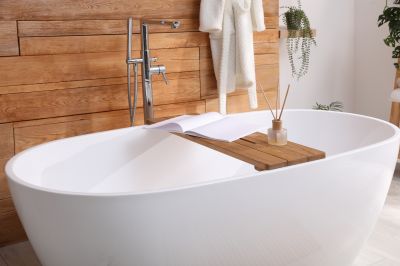Favorite Tools And Supplies For Bathtub Installation Projects
Get the essential products trusted by homeowners and contractors for smooth and successful bathtub installations.
 Installing a bathtub involves selecting the right products to ensure a safe, durable, and functional setup. The process begins with understanding the different types of bathtubs available, such as alcove, freestanding, corner, and drop-in models. Each type requires specific installation components and considerations to fit seamlessly into your bathroom space. Proper planning also involves choosing suitable plumbing fixtures, drain assemblies, and sealants to prevent leaks and ensure long-term performance.
Installing a bathtub involves selecting the right products to ensure a safe, durable, and functional setup. The process begins with understanding the different types of bathtubs available, such as alcove, freestanding, corner, and drop-in models. Each type requires specific installation components and considerations to fit seamlessly into your bathroom space. Proper planning also involves choosing suitable plumbing fixtures, drain assemblies, and sealants to prevent leaks and ensure long-term performance.
Top Overall Option
Universal Bathtub Installation Kit
A comprehensive installation kit that includes essential components such as adjustable mounting brackets, waterproof sealants, drain assemblies, and detailed instructions. Designed to accommodate various bathtub types and sizes, it offers versatility and convenience for both DIY enthusiasts and professionals. The kit's compatibility with standard plumbing fittings makes it a reliable choice for ensuring a secure and leak-free installation.
Types of Products For Bathtub Installations
Alcove Bathtubs and Surrounds
Designed for installation in a three-wall alcove, these units often come with matching surrounds for a cohesive look.
Freestanding Bathtubs
Standalone tubs that can be placed anywhere with proper plumbing access, offering flexibility in bathroom design.
Corner Bathtubs
Optimized for corner spaces, these tubs maximize bathroom footprint while providing a spacious bathing area.
Drop-In Bathtubs
Installed into a pre-built deck or surround, these tubs require precise fitting and support structures.
Walk-In Bathtubs
Designed for accessibility, featuring door access and low thresholds for ease of entry.
Clawfoot Bathtubs
Classic style units that rest on decorative feet, often requiring specific support and plumbing arrangements.
Soaking Tubs
Deep tubs intended for relaxation, compatible with various installation types depending on design.
Jacuzzi and Whirlpool Tubs
Tubs equipped with jets for hydrotherapy, requiring specialized plumbing and wiring.
Inset Bathtubs
Designed to be recessed into a deck or platform, providing a sleek, integrated look.
Vessel Bathtubs
Sit atop the bathroom floor and often serve as statement pieces, requiring specific support and plumbing considerations.
Barrier-Free Tubs
Designed for accessibility, these tubs eliminate barriers for easier entry.
Convertible Tubs
Feature multi-functional designs, such as combining shower and bathtub functionalities.
Popular Choices
Lightweight and versatile, these tubs are popular for their ease of installation and maintenance.
Durable and classic, offering excellent heat retention and sturdy support.
Cost-effective and easy to install, suitable for various bathroom styles.
Maximize space in smaller bathrooms while providing a comfortable bathing area.
Increasingly chosen for accessibility, with features designed for safety and convenience.
Popular for modern aesthetics, often paired with vessel sinks and contemporary fixtures.
Chosen for relaxation features, requiring specific installation components.
Favored for their seamless appearance when integrated into custom surrounds.
A timeless choice that adds vintage charm to bathrooms.
Preferred for their spaciousness and comfort, suitable for various installation types.
Common in standard bathrooms, compatible with shower enclosures.
Adding a focal point to the bathroom, with flexible placement options.
Beyond the bathtub itself, supporting accessories like mounting brackets, reinforcement materials, and waterproof membranes can enhance installation stability. For those undertaking a renovation or new build, understanding the compatibility of these products with existing plumbing and bathroom configurations is crucial. It is also wise to consider accessibility features, especially if the bathtub will be used by individuals with mobility needs, which might influence the choice of grab bars, walk-in features, or textured surfaces.
While selecting products, attention to quality and compatibility is key, but it is equally important to adhere to local building codes and manufacturer instructions. Proper installation not only ensures safety but can also extend the lifespan of the bathtub and related fixtures. Consulting with professionals or experienced DIYers can provide valuable insights into the best practices for your specific project in Roscoe, IL, ensuring a smooth installation process and a satisfying outcome.
Key Buying Considerations
- Determine the available space and measure accurately to select an appropriately sized bathtub.
- Choose the type of bathtub that best fits your bathroom layout and aesthetic preferences.
- Verify compatibility with existing plumbing fixtures and ensure access for necessary connections.
- Consider the material of the tub for durability, maintenance, and heat retention properties.
- Assess the weight of the bathtub, especially if installing a heavy material like cast iron, and ensure the floor can support it.
- Review installation requirements, including support structures, reinforcement, and sealing methods.
- Check for accessibility features if needed, such as low thresholds or grab bars.
- Evaluate the ease of cleaning and maintenance for the selected product.
- Ensure compliance with local building codes and safety standards.
- Plan for adequate water supply and drainage, including venting and overflow considerations.
- Think about the style and finish that complements your bathroom decor.
- Consider additional features like jets, heating, or integrated shelving based on preferences.
- Budget for both the product and potential installation services or tools needed.
- Read product specifications carefully to understand installation complexity and requirements.
